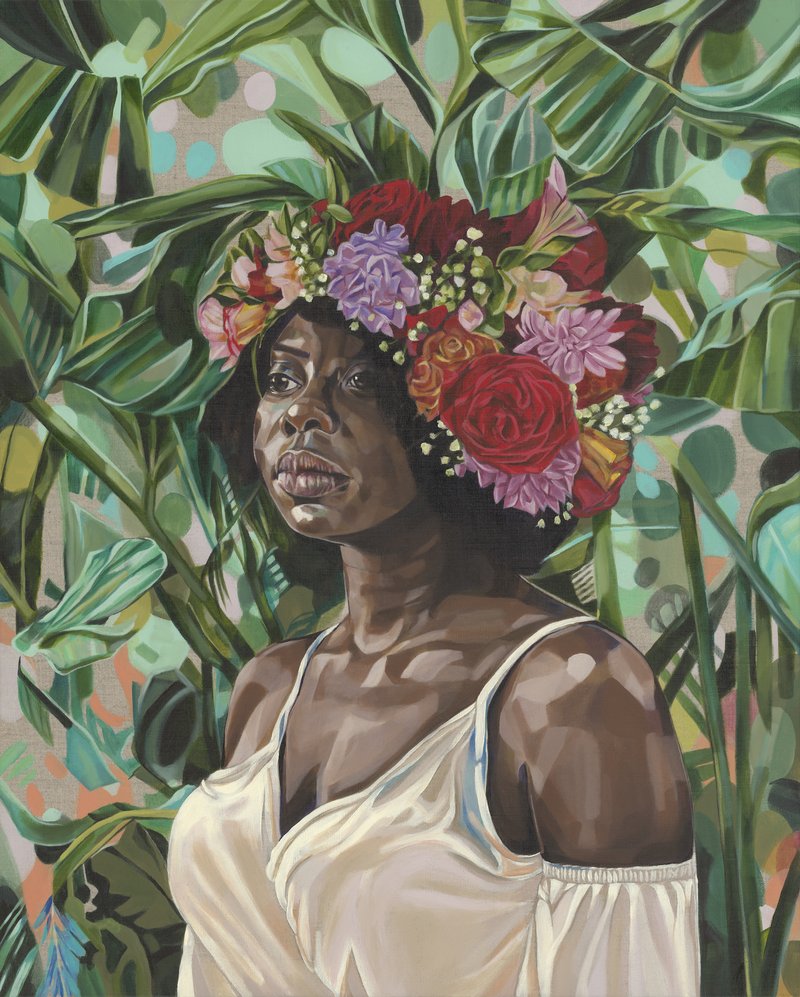Choose to Challenge
Image: Tamara Armstrong, Melanin Garden - A Portrait of Anisa Nandaula, 2019. Acrylic on linen, 64 x 80 cm.
Image: Tamara Armstrong, Melanin Garden - A Portrait of Anisa Nandaula, 2019. Acrylic on linen, 64 x 80 cm.

Image Description: The image depicts a portrait of a woman. In this painting, she is wearing a cream blouse, and a colourful wreath of orange, pink, and purple flowers on her head. In the background, there is lush green foliage in an abstract style. She is staring confidently into the distance.
Call out racism and sexism and use courage to rub it out. Stand where the rest of the world has chosen to sit. Call out at home, at work, at school.
Excerpt from Choose to Challenge by Anisa Nandaula, Brisbane-based spoken word poet and writer.
The theme of this year’s International Women’s Day is Choose to Challenge. Recognising that change comes from challenging the status quo, the theme encourages all of us to call out gender bias and inequality; seek out and celebrate women's achievements; and help create an inclusive world.
Under systems of power which are so strong, it is no wonder we are afraid to call out inequities and injustices. This weekend four artists and activists from the Department of Homo Affairs (DoHA) were arrested and fined when they intercepted the Federal and NSW Police and Corrective Services floats in the Sydney Mardi Gras parade to call out ongoing racist, homophobic and transphobic policing. Meanwhile, allegations of rape in Parliament House in recent weeks have reminded us that when women speak up about harassment, they suffer great professional and personal harm. In highlighting the priority of ‘choosing to challenge’, we must also remember to protect and support those who publicly voice their experiences of misogyny, racism, and other misconduct, and have become vulnerable to further abuse and backlash.
While we've seen some significant achievements across the visual arts in recent years, it is no secret that gender inequity remains a serious problem across the industry. One of the overarching takeaways from NAVA’s consultation sessions for its major revision of the Code of Practice to date is that issues of accessibility, diversity, inclusion and cultural safety remain largely unaddressed by artists and organisations across the sector. Addressing these as a priority is crucial to our work on the Code of Practice – both in the process of revising it and in the final form of the Code itself. Central to achieving best practice is the centering of First Nations artists, arts workers, communities, and experts. There must be an ethical and non-superficial inclusion of our full diversity of voices - including communities that are culturally minoritised, LGBTIQA+, working-class, living with disability - and others impacted by historic and contemporary marginalisation.
The new introductory section of NAVA's Code of Practice for the Australian Visual Arts Sector will be titled Principles, Ethics and Rights. Setting the tone for new industry standards, this section will cover a range of legislation, best practices and recommended guidelines around gender equity, legal rights, social justice, and workplace behaviours that link to protocols that are led and maintained by specific authorities.
This new section will bolster the ethical framework of the Code, offering a useful starting point for conversations about the civic and cultural roles of the contemporary arts sector and its many players and stakeholders. When discussing equity, the revised Code will provide information on good practices and strategies for visual artists, arts workers and organisations to drive change across the industry.
At a glance, the slogan ‘choose to challenge’ might call to mind an image of a solitary artist or arts worker trying to confront the workings of entire systems and institutions. This image might seem discouraging, the task unattainable. But disrupting patterns of inequity does not have to be done alone, nor necessarily must it take the form of a watershed public statement.
Choosing to challenge can take on many forms. It can mean putting forward other names when you sense that you are not equipped for a particular role. It can mean making informed choices about where and how you participate, by asking who else is speaking on the panel or who else is in the exhibition. It can mean asking questions when important perspectives are excluded from decision-making processes. It can mean slowing down and taking the time to properly change the policies and procedures of your organisation. The task of change is still a difficult one - but through collectivity and commitment, it is far from unattainable.
Penelope Benton and Naomi Segal